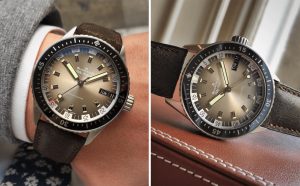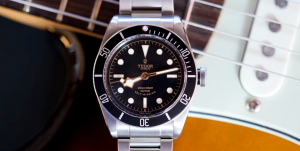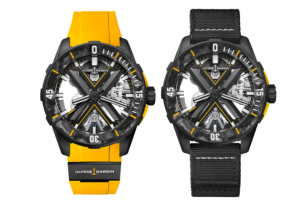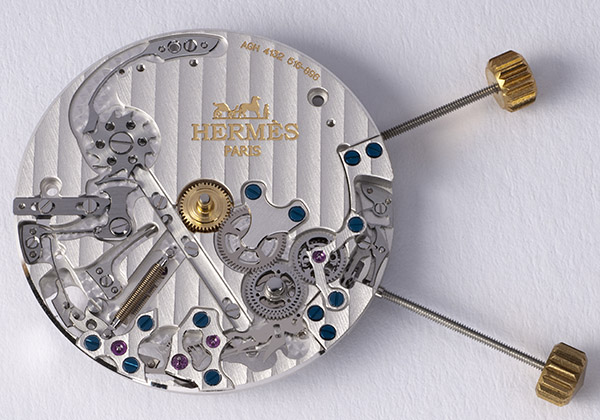
When reading spec sheets, we sometimes come across the ambiguous term “module”. It’s a rather vague and imprecise word, which can have any number of meanings. It can refer to the shape of a cigar, a space ship or, in the present context – watchmaking – a complication plate. Clear as mud? Thought so. Let’s have a little chat about movements.
A movement is like a wedding cake. It can have several layers. As a minimum, it supplies the basic functions required of a watch engine. It will count the hours and the minutes and, even if it doesn’t necessarily display them, the seconds. To achieve this, it relies on several organs working together as a system: an energy source (the barrel), a system for measuring time (balance / balance spring and escapement), a transmission (the gears) and an interface with the wearer (the display). This is what is generally known as a base movement, sometimes referred to as a “tractor”.

The alarm / countdown module of the Slim d’Hermès Heure Impatiente © Eveline Perroud
However, a calibre can also offer any number of additional indications. A quick back-of-the-envelope calculation brings us to well over a hundred complications and combinations thereof. How are they supplied? There are two approaches. The first is to start off with the base movement, and on top of that, graft a separate bloc that deals with one or more additional functions. This is the module. It’s called a complication plate because it is in the shape of a circular plaque. But it’s not autonomous. It borrows its energy and timekeeping functions from the base movement, which carries and supplies it (hence the term “tractor”).
The advantage of a module is that it can be made separately and grafted onto different movements. It’s also far simpler than a base calibre, which makes it relatively economical to produce. It enhances calibres with useful functions such as additional time zones, big dates, power reserves and moon phase displays. It is indispensable when it comes to exotic displays such as wandering hours and retrograde functions. The disadvantage is that it is superimposed on top of the base movement, and any protrusions have to project at a different level. To give a typical example, in a chronograph module (from Audemars Piguet or Girard-Perregaux), the pushers are not on the same plane as the crown. Even worse, the date, which is often part of the base movement, looks like it’s at the bottom of a well.
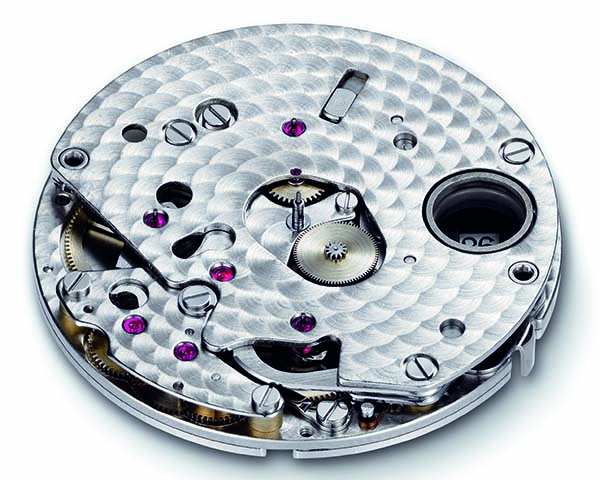
A chronograph with modular construction © Audemars Piguet
An alternative approach is an integrated movement. All the complications interact under the same roof, on a single plate, within a single unified whole. This construction is aesthetically more elegant, and it has a valuable functional advantage in that it is far thinner. Indeed, an integrated construction can incorporate functions in the lateral rather than the vertical plane. This is the case with Oris’s calibre 113, which includes a day, date, month and week number within a movement the same height as the calibre 110.
There is a third, rarer and more exclusive approach. A semi-integrated construction involves grafting organs onto a base movement. Rather than having their own plate, which adds precious millimetres to the height, these complications are inserted into voids created in an existing movement. This approach shaves off millimetres, but adds significant complexity. It is nevertheless the only approach that gets around the problem of developing an entirely new movement for each combination of complications. This is why Patek Philippe and A. Lange & Söhne adopt this approach for their grand complications.
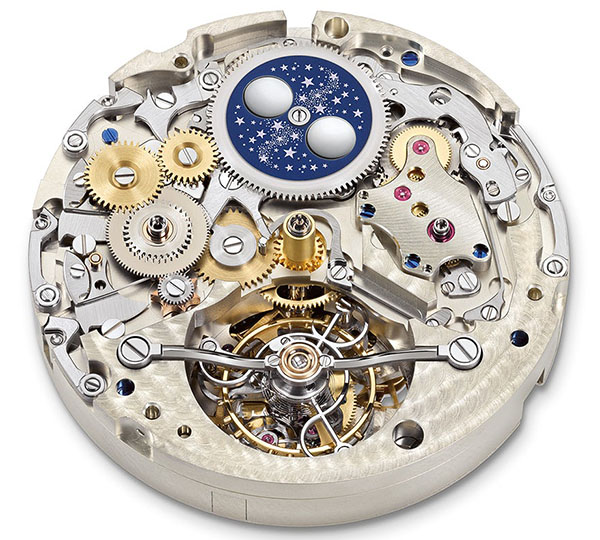
The constant force split-seconds perpetual calendar tourbillon calibre of A. Lange & Söhne’s Tourbograph “Pour le Mérite” is semi-integrated © A. Lange & Söhne
The Saxonia collection represents entry level pricing for A. Lange & Söhne, and you will find two versions of the Saxonia, one in white gold and the other in pink stone. Both are priced at $16,100. In contrast, the 37mm men’s Saxonia is priced at $14,800, (together with all the Caliber L093.1) and the 40mm at $24,500. But neither of them have the small moments or mother-of-pearl dial. Both the Little Lange 1 Moon Phase and Saxonia cater to distinct sub-markets in the ladies watch marketplace and Lange has introduced some truly fantastic pieces.The Salon International de la Haute Horlogerie 2017 is now concluded, and the aBlogtoWatch team is predictably exhausted. We tried something new this season — a movie log (vlog) series — to help catch what it is like to be at the show. Combining high excitement and energy-draining hours, we’re happy people enjoyed that very intimate look behind the scenes and what it is like to attend the “world’s most esteemed” high-end watch trade show.In my 9th year attending SIHH (itself in its 27th year) I’d like to once again recap the general sentiment of this show in addition to point out key highlights that we believe the overall watch-loving public ought to be excited about in 2017. Before we get to our top 11 watches of SIHH 2017, I’d love to explore the overall watch and luxury industry setting so that folks get a clearer idea of why particular goods are being created — and also for whom.It was a particularly cold and blustery week in Geneva, Switzerland, throughout SIHH 2017. Our accommodations near Lake Geneva provided a first-rate view of what struck me as a suitable metaphor for the industry’s current circumstance. High winds blew across the water causing not just surfable waves (if you have an Iceman-like tolerance for cold) but also spilling on the adjoining walking trails that from the spring and summer make for popular strolling avenues for lovers and languishers alike. The seas and ominous lake waves seemed a fitting metaphor for the luxury watch industry which is continuing to undergo a storm.
